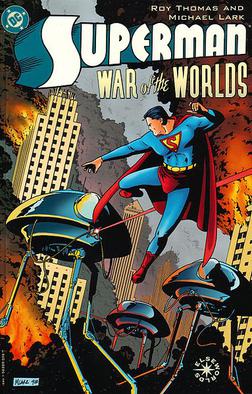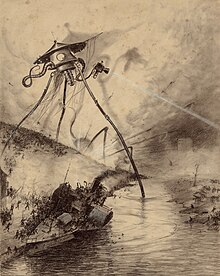
Alien invasion or space invasion is a common feature in science fiction stories and film, in which extraterrestrial lifeforms invade the Earth to exterminate and supplant human life, enslave it, harvest people for food, steal the planet's resources, or destroy the planet altogether. It can be considered as a science-fiction subgenre of the invasion literature, expanded by H. G. Wells's seminal alien invasion novel The War of the Worlds, and is a type of "first contact" science fiction.

Jeff Wayne's Musical Version of The War of the Worlds is a studio double album by American-born British musician, composer, and record producer Jeff Wayne, released on 9 June 1978 by CBS Records. It is an album musical adapted from the science-fiction novel The War of the Worlds by H. G. Wells in a rock opera style with a rock band, orchestra, narrator, and leitmotifs to carry the story and lyrics that express the feelings of the various characters. The album features guest artists David Essex, Justin Hayward, Phil Lynott, Chris Thompson, and Julie Covington, with actor Richard Burton as the narrator.

War of the Worlds is a 2005 American science fiction action-thriller film directed by Steven Spielberg and written by Josh Friedman and David Koepp, based on H. G. Wells' 1898 novel, The War of the Worlds. Tom Cruise stars in the main role alongside Dakota Fanning, Miranda Otto, and Tim Robbins, with narration by Morgan Freeman. It follows an American dock worker who must look after his children, from whom he lives separately, as he struggles to protect them and reunite them with their mother when extraterrestrials invade Earth and devastate cities with giant war machines.

H. G. Wells' War of the Worlds, also known as Invasion and H. G. Wells' The Worlds in War internationally, or simply as War of the Worlds, is a 2005 Japanese-American direct-to-DVD independent science fiction action horror film produced by The Asylum, which premiered on Sci Fi Channel on Tuesday June 28, 2005, and directed by David Michael Latt. It is a loose adaptation of the H. G. Wells novel, and a mockbuster of the DreamWorks/Paramount film based on the same source, in addition to the third film adaptation overall.

HMS Thunder Child is a fictional ironclad torpedo ram of the Royal Navy, destroyed by Martian fighting-machines in H. G. Wells' 1898 novel The War of the Worlds whilst protecting a refugee rescue fleet of civilian vessels. It has been suggested that Thunder Child was based on HMS Polyphemus, which was the sole torpedo ram to see service with the Royal Navy from 1881 to 1903.

The First Men in the Moon is a scientific romance, originally serialised in The Strand Magazine and The Cosmopolitan from November 1900 to June 1901 and published in hardcover in 1901, by the English author H. G. Wells, who called it one of his "fantastic stories". The novel tells the story of a journey to the Moon undertaken by the two protagonists: a businessman narrator, Mr. Bedford; and an eccentric scientist, Mr. Cavor. Bedford and Cavor discover that the Moon is inhabited by a sophisticated extraterrestrial civilisation of insect-like creatures they call "Selenites". The inspiration seems to come from the famous 1865 book by Jules Verne, From the Earth to the Moon, and the opera by Jacques Offenbach from 1875. Verne's novel also uses the word "Selenites" to describe inhabitants of the Moon.

The Chessmen of Mars is a science fantasy novel by American writer Edgar Rice Burroughs, the fifth of his Barsoom series. Burroughs began writing it in January, 1921, and the finished story was first published in Argosy All-Story Weekly as a six-part serial in the issues for February 18 and 25 and March 4, 11, 18 and 25, 1922. It was later published as a complete novel by A. C. McClurg in November 1922.

The Martians, also known as the Invaders, are the main antagonists from the H.G. Wells 1898 novel The War of the Worlds. Their efforts to exterminate the populace of the Earth and claim the planet for themselves drive the plot and present challenges for the novel's human characters. They are notable for their use of extraterrestrial weaponry far in advance of that of mankind at the time of the invasion.

Scarlet Traces is a Steampunk comic series written by Ian Edginton and illustrated by D'Israeli. It was originally published online before being serialised in 2002, in the British anthology Judge Dredd Megazine. A sequel, Scarlet Traces: The Great Game, followed in 2006.

Edison's Conquest of Mars is an 1898 science fiction novel by American astronomer and writer Garrett P. Serviss. It was written as a sequel to Fighters from Mars, an unauthorized and heavily altered version of H. G. Wells's 1897 story The War of the Worlds. It has a place in the history of science fiction for its early employment of themes and motifs that later became staples of the genre.

Superman: War of the Worlds is a DC Comics Elseworlds comic story, published in 1998, written by Roy Thomas with Michael Lark as the artist. The story is a rough adaptation of the H. G. Wells 1898 novel The War of the Worlds, but is primarily based on the Superman mythology. Wells' story is transported from early 20th century Britain to Metropolis in 1938, where the Martian invasion is met with a Golden Age-style Superman who is not blessed with the full range of powers that he typically has in modern comics.

H. G. Wells' The War of the Worlds is a 2005 direct-to-video independent science fiction action horror-thriller film version adaptation of H. G. Wells's 1898 novel of the same name about a Martian invasion of southern England. This version was produced by the independent film company Pendragon Pictures. Unlike the adaptations set in the current day United States, this was the first film set in the novel's original 1898 Victorian England. In 2012, a re-formatted, re-worked version of the film was released as War of the Worlds – The True Story.

The League of Extraordinary Gentlemen, Volume II is a comic book limited series written by Alan Moore and illustrated by Kevin O'Neill, published under the America's Best Comics imprint of DC Comics in the United States and under Vertigo in the United Kingdom. It is a sequel to the original volume of The League of Extraordinary Gentlemen and like its previous installment is a pastiche of various characters and events from Victorian literature; though it borrows a great number of characters and elements from various literary works of writers such as Sir Arthur Conan Doyle, Edgar Rice Burroughs, Ian Fleming, Robert Louis Stevenson and Bram Stoker, it is predominantly a retelling of The War of the Worlds by H. G. Wells.

War of the Worlds 2: The Next Wave is a 2008 direct-to-DVD science fiction-action film by The Asylum, which premiered on Syfy on Tuesday March 18, 2008, directed by and starring C. Thomas Howell. The film was produced and distributed independently by The Asylum.

Barsoom is a fictional representation of the planet Mars created by American pulp fiction author Edgar Rice Burroughs. The first Barsoom tale was serialized as Under the Moons of Mars in pulp magazine The All-Story from February to July 1912 and published compiled as a novel as A Princess of Mars in 1917. It features John Carter, a late-19th-century American Confederate veteran who is mysteriously transported from Earth to the dying world of Mars where he meets and romances the beautiful Martian princess Dejah Thoris. Ten sequels followed over the next three decades, further extending his vision of Barsoom and adding other characters.

The War of the Worlds is a 1953 American science fiction film directed by Byron Haskin, produced by George Pal, and starring Gene Barry and Ann Robinson. It is the first of several feature film adaptations of H. G. Wells' 1898 novel of the same name. The setting is changed from Victorian era England to 1953 Southern California.

War of the Worlds: Goliath is a 2012 Malaysian animated science fiction war film directed by Joe Pearson that was released in 15 November 2012 in Malaysia. The film is voiced by actors Peter Wingfield, Adrian Paul, Tony Eusoff, Elizabeth Gracen, Jim Byrnes, Rob Middleton, Mark Sheppard, Matt Letscher, Adam Baldwin and other voice actors. The film is a loose sequel to H. G. Wells' 1898 novel The War of the Worlds. Its title refers to the human tripod the main characters use in the film. The film was negatively received, with the Los Angeles Times calling it "violent, messily drawn and lifelessly dragging" and The New York Times calling it "remarkably uninvolving".

The War of the Worlds is a science fiction novel by English author H. G. Wells. It was written between 1895 and 1897, and serialised in Pearson's Magazine in the UK and Cosmopolitan magazine in the US in 1897. The full novel was first published in hardcover in 1898 by William Heinemann. The War of the Worlds is one of the earliest stories to detail a conflict between humankind and an extraterrestrial race. The novel is the first-person narrative of an unnamed protagonist in Surrey and his younger brother who escapes to Tillingham in Essex as London and southern England is invaded by Martians. It is one of the most commented-on works in the science fiction canon.

The Massacre of Mankind (2017) is a science fiction novel by the British writer Stephen Baxter, a sequel to H. G. Wells' 1898 classic The War of the Worlds, authorised by the Wells estate. It is set in 1920, 13 years after the events of the original novel, as a second Martian invasion is chronicled by Miss Elphinstone, the ex-sister-in-law of the narrator of War of the Worlds. Baxter also wrote an authorised sequel to Wells' novel The Time Machine, called The Time Ships.




















